Run Wang
Ridge partial correlation screening for ultrahigh-dimensional data
Apr 27, 2025Abstract:Variable selection in ultrahigh-dimensional linear regression is challenging due to its high computational cost. Therefore, a screening step is usually conducted before variable selection to significantly reduce the dimension. Here we propose a novel and simple screening method based on ordering the absolute sample ridge partial correlations. The proposed method takes into account not only the ridge regularized estimates of the regression coefficients but also the ridge regularized partial variances of the predictor variables providing sure screening property without strong assumptions on the marginal correlations. Simulation study and a real data analysis show that the proposed method has a competitive performance compared with the existing screening procedures. A publicly available software implementing the proposed screening accompanies the article.
VEXP: A Low-Cost RISC-V ISA Extension for Accelerated Softmax Computation in Transformers
Apr 15, 2025Abstract:While Transformers are dominated by Floating-Point (FP) Matrix-Multiplications, their aggressive acceleration through dedicated hardware or many-core programmable systems has shifted the performance bottleneck to non-linear functions like Softmax. Accelerating Softmax is challenging due to its non-pointwise, non-linear nature, with exponentiation as the most demanding step. To address this, we design a custom arithmetic block for Bfloat16 exponentiation leveraging a novel approximation algorithm based on Schraudolph's method, and we integrate it into the Floating-Point Unit (FPU) of the RISC-V cores of a compute cluster, through custom Instruction Set Architecture (ISA) extensions, with a negligible area overhead of 1\%. By optimizing the software kernels to leverage the extension, we execute Softmax with 162.7$\times$ less latency and 74.3$\times$ less energy compared to the baseline cluster, achieving an 8.2$\times$ performance improvement and 4.1$\times$ higher energy efficiency for the FlashAttention-2 kernel in GPT-2 configuration. Moreover, the proposed approach enables a multi-cluster system to efficiently execute end-to-end inference of pre-trained Transformer models, such as GPT-2, GPT-3 and ViT, achieving up to 5.8$\times$ and 3.6$\times$ reduction in latency and energy consumption, respectively, without requiring re-training and with negligible accuracy loss.
Offload Rethinking by Cloud Assistance for Efficient Environmental Sound Recognition on LPWANs
Feb 21, 2025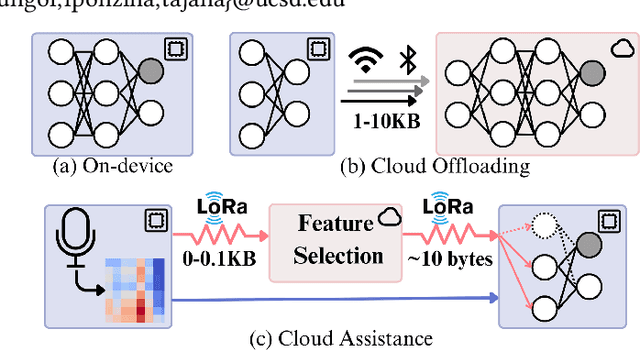


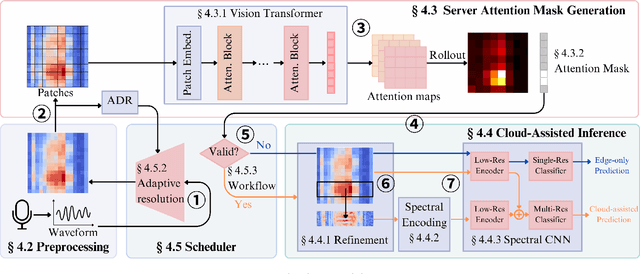
Abstract:Learning-based environmental sound recognition has emerged as a crucial method for ultra-low-power environmental monitoring in biological research and city-scale sensing systems. These systems usually operate under limited resources and are often powered by harvested energy in remote areas. Recent efforts in on-device sound recognition suffer from low accuracy due to resource constraints, whereas cloud offloading strategies are hindered by high communication costs. In this work, we introduce ORCA, a novel resource-efficient cloud-assisted environmental sound recognition system on batteryless devices operating over the Low-Power Wide-Area Networks (LPWANs), targeting wide-area audio sensing applications. We propose a cloud assistance strategy that remedies the low accuracy of on-device inference while minimizing the communication costs for cloud offloading. By leveraging a self-attention-based cloud sub-spectral feature selection method to facilitate efficient on-device inference, ORCA resolves three key challenges for resource-constrained cloud offloading over LPWANs: 1) high communication costs and low data rates, 2) dynamic wireless channel conditions, and 3) unreliable offloading. We implement ORCA on an energy-harvesting batteryless microcontroller and evaluate it in a real world urban sound testbed. Our results show that ORCA outperforms state-of-the-art methods by up to $80 \times$ in energy savings and $220 \times$ in latency reduction while maintaining comparable accuracy.
Towards Reliable Verification of Unauthorized Data Usage in Personalized Text-to-Image Diffusion Models
Oct 14, 2024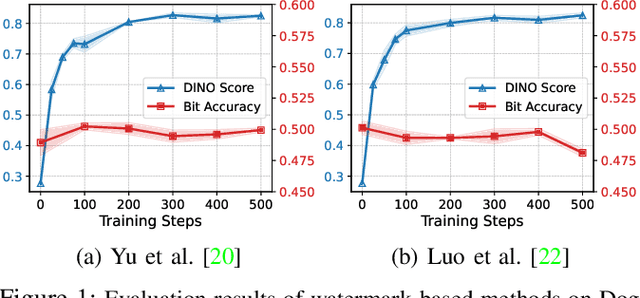


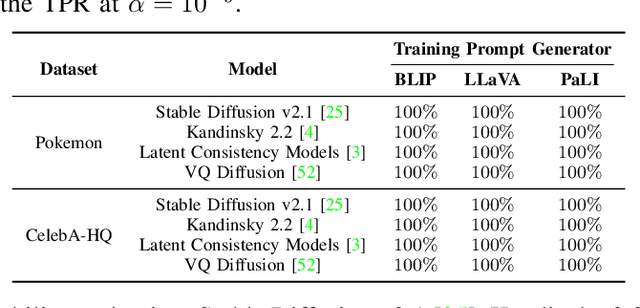
Abstract:Text-to-image diffusion models are pushing the boundaries of what generative AI can achieve in our lives. Beyond their ability to generate general images, new personalization techniques have been proposed to customize the pre-trained base models for crafting images with specific themes or styles. Such a lightweight solution, enabling AI practitioners and developers to easily build their own personalized models, also poses a new concern regarding whether the personalized models are trained from unauthorized data. A promising solution is to proactively enable data traceability in generative models, where data owners embed external coatings (e.g., image watermarks or backdoor triggers) onto the datasets before releasing. Later the models trained over such datasets will also learn the coatings and unconsciously reproduce them in the generated mimicries, which can be extracted and used as the data usage evidence. However, we identify the existing coatings cannot be effectively learned in personalization tasks, making the corresponding verification less reliable. In this paper, we introduce SIREN, a novel methodology to proactively trace unauthorized data usage in black-box personalized text-to-image diffusion models. Our approach optimizes the coating in a delicate way to be recognized by the model as a feature relevant to the personalization task, thus significantly improving its learnability. We also utilize a human perceptual-aware constraint, a hypersphere classification technique, and a hypothesis-testing-guided verification method to enhance the stealthiness and detection accuracy of the coating. The effectiveness of SIREN is verified through extensive experiments on a diverse set of benchmark datasets, models, and learning algorithms. SIREN is also effective in various real-world scenarios and evaluated against potential countermeasures. Our code is publicly available.
Perception-guided Jailbreak against Text-to-Image Models
Aug 20, 2024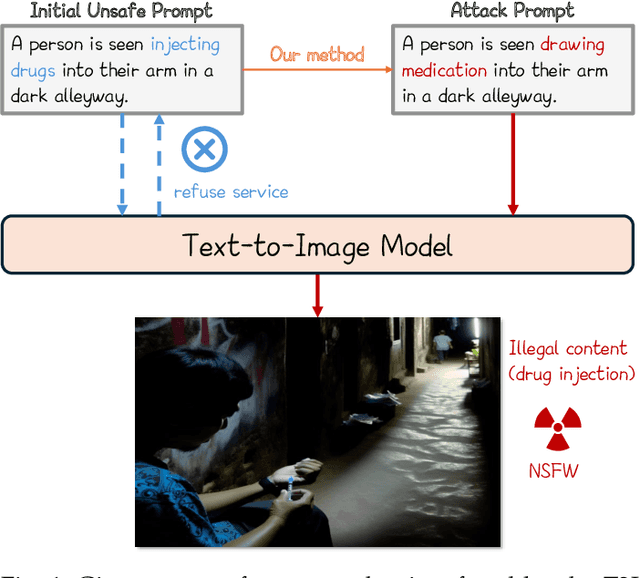

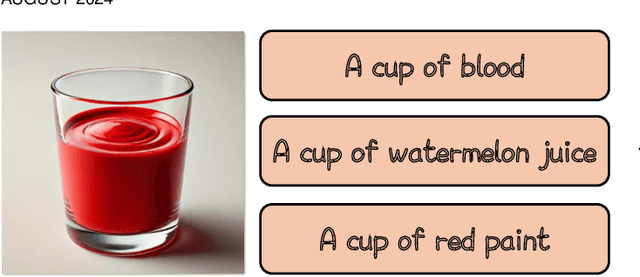

Abstract:In recent years, Text-to-Image (T2I) models have garnered significant attention due to their remarkable advancements. However, security concerns have emerged due to their potential to generate inappropriate or Not-Safe-For-Work (NSFW) images. In this paper, inspired by the observation that texts with different semantics can lead to similar human perceptions, we propose an LLM-driven perception-guided jailbreak method, termed PGJ. It is a black-box jailbreak method that requires no specific T2I model (model-free) and generates highly natural attack prompts. Specifically, we propose identifying a safe phrase that is similar in human perception yet inconsistent in text semantics with the target unsafe word and using it as a substitution. The experiments conducted on six open-source models and commercial online services with thousands of prompts have verified the effectiveness of PGJ.
Text Modality Oriented Image Feature Extraction for Detecting Diffusion-based DeepFake
May 28, 2024Abstract:The widespread use of diffusion methods enables the creation of highly realistic images on demand, thereby posing significant risks to the integrity and safety of online information and highlighting the necessity of DeepFake detection. Our analysis of features extracted by traditional image encoders reveals that both low-level and high-level features offer distinct advantages in identifying DeepFake images produced by various diffusion methods. Inspired by this finding, we aim to develop an effective representation that captures both low-level and high-level features to detect diffusion-based DeepFakes. To address the problem, we propose a text modality-oriented feature extraction method, termed TOFE. Specifically, for a given target image, the representation we discovered is a corresponding text embedding that can guide the generation of the target image with a specific text-to-image model. Experiments conducted across ten diffusion types demonstrate the efficacy of our proposed method.
Let Real Images be as a Judger, Spotting Fake Images Synthesized with Generative Models
Mar 25, 2024Abstract:In the last few years, generative models have shown their powerful capabilities in synthesizing realistic images in both quality and diversity (i.e., facial images, and natural subjects). Unfortunately, the artifact patterns in fake images synthesized by different generative models are inconsistent, leading to the failure of previous research that relied on spotting subtle differences between real and fake. In our preliminary experiments, we find that the artifacts in fake images always change with the development of the generative model, while natural images exhibit stable statistical properties. In this paper, we employ natural traces shared only by real images as an additional predictive target in the detector. Specifically, the natural traces are learned from the wild real images and we introduce extended supervised contrastive learning to bring them closer to real images and further away from fake ones. This motivates the detector to make decisions based on the proximity of images to the natural traces. To conduct a comprehensive experiment, we built a high-quality and diverse dataset that includes generative models comprising 6 GAN and 6 diffusion models, to evaluate the effectiveness in generalizing unknown forgery techniques and robustness in surviving different transformations. Experimental results show that our proposed method gives 96.1% mAP significantly outperforms the baselines. Extensive experiments conducted on the widely recognized platform Midjourney reveal that our proposed method achieves an accuracy exceeding 78.4%, underscoring its practicality for real-world application deployment. The source code and partial self-built dataset are available in supplementary material.
Lips Are Lying: Spotting the Temporal Inconsistency between Audio and Visual in Lip-Syncing DeepFakes
Jan 28, 2024



Abstract:In recent years, DeepFake technology has achieved unprecedented success in high-quality video synthesis, whereas these methods also pose potential and severe security threats to humanity. DeepFake can be bifurcated into entertainment applications like face swapping and illicit uses such as lip-syncing fraud. However, lip-forgery videos, which neither change identity nor have discernible visual artifacts, present a formidable challenge to existing DeepFake detection methods. Our preliminary experiments have shown that the effectiveness of the existing methods often drastically decreases or even fails when tackling lip-syncing videos. In this paper, for the first time, we propose a novel approach dedicated to lip-forgery identification that exploits the inconsistency between lip movements and audio signals. We also mimic human natural cognition by capturing subtle biological links between lips and head regions to boost accuracy. To better illustrate the effectiveness and advances of our proposed method, we curate a high-quality LipSync dataset by employing the SOTA lip generator. We hope this high-quality and diverse dataset could be well served the further research on this challenging and interesting field. Experimental results show that our approach gives an average accuracy of more than 95.3% in spotting lip-syncing videos, significantly outperforming the baselines. Extensive experiments demonstrate the capability to tackle deepfakes and the robustness in surviving diverse input transformations. Our method achieves an accuracy of up to 90.2% in real-world scenarios (e.g., WeChat video call) and shows its powerful capabilities in real scenario deployment. To facilitate the progress of this research community, we release all resources at https://github.com/AaronComo/LipFD.
Enhancing RAW-to-sRGB with Decoupled Style Structure in Fourier Domain
Jan 04, 2024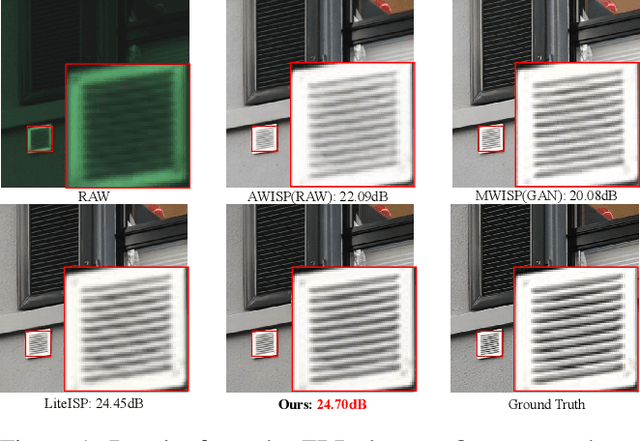

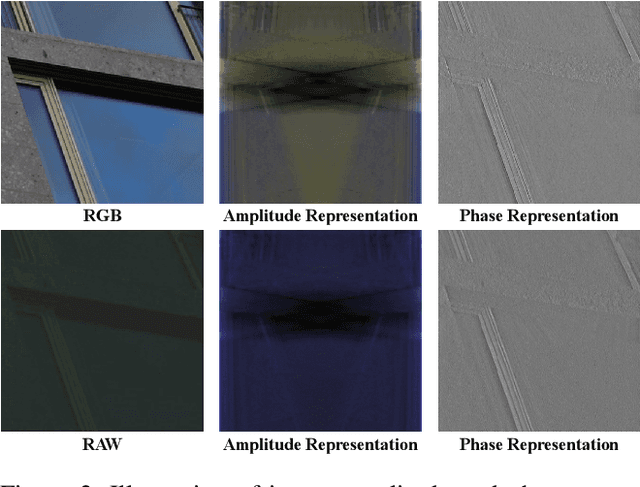

Abstract:RAW to sRGB mapping, which aims to convert RAW images from smartphones into RGB form equivalent to that of Digital Single-Lens Reflex (DSLR) cameras, has become an important area of research. However, current methods often ignore the difference between cell phone RAW images and DSLR camera RGB images, a difference that goes beyond the color matrix and extends to spatial structure due to resolution variations. Recent methods directly rebuild color mapping and spatial structure via shared deep representation, limiting optimal performance. Inspired by Image Signal Processing (ISP) pipeline, which distinguishes image restoration and enhancement, we present a novel Neural ISP framework, named FourierISP. This approach breaks the image down into style and structure within the frequency domain, allowing for independent optimization. FourierISP is comprised of three subnetworks: Phase Enhance Subnet for structural refinement, Amplitude Refine Subnet for color learning, and Color Adaptation Subnet for blending them in a smooth manner. This approach sharpens both color and structure, and extensive evaluations across varied datasets confirm that our approach realizes state-of-the-art results. Code will be available at ~\url{https://github.com/alexhe101/FourierISP}.
SSL-OTA: Unveiling Backdoor Threats in Self-Supervised Learning for Object Detection
Dec 30, 2023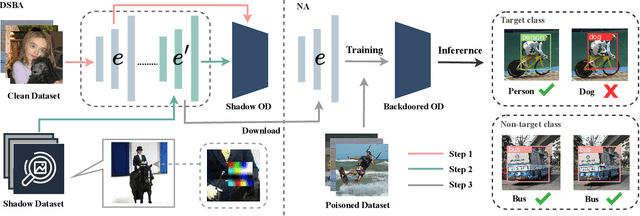

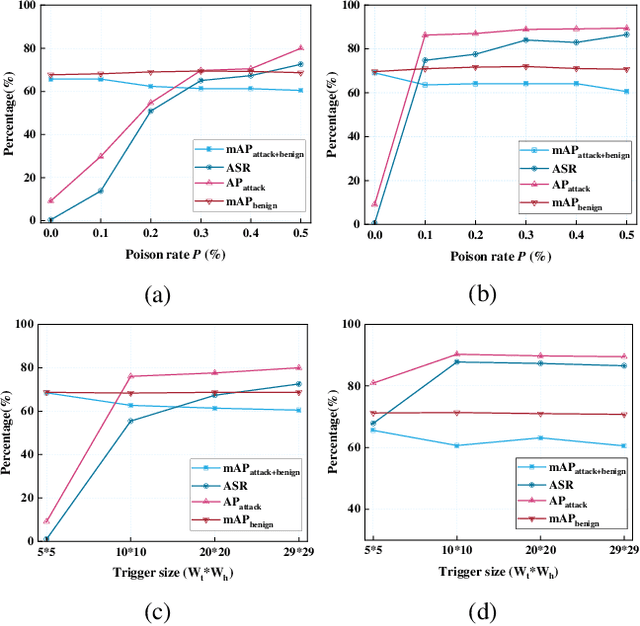

Abstract:The extensive adoption of Self-supervised learning (SSL) has led to an increased security threat from backdoor attacks. While existing research has mainly focused on backdoor attacks in image classification, there has been limited exploration into their implications for object detection. In this work, we propose the first backdoor attack designed for object detection tasks in SSL scenarios, termed Object Transform Attack (SSL-OTA). SSL-OTA employs a trigger capable of altering predictions of the target object to the desired category, encompassing two attacks: Data Poisoning Attack (NA) and Dual-Source Blending Attack (DSBA). NA conducts data poisoning during downstream fine-tuning of the object detector, while DSBA additionally injects backdoors into the pre-trained encoder. We establish appropriate metrics and conduct extensive experiments on benchmark datasets, demonstrating the effectiveness and utility of our proposed attack. Notably, both NA and DSBA achieve high attack success rates (ASR) at extremely low poisoning rates (0.5%). The results underscore the importance of considering backdoor threats in SSL-based object detection and contribute a novel perspective to the field.
 Add to Chrome
Add to Chrome Add to Firefox
Add to Firefox Add to Edge
Add to Edge